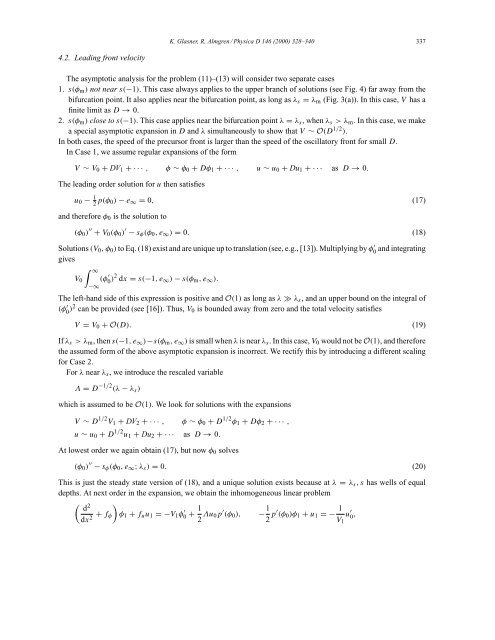Dual fronts in a phase field model
Dual fronts in a phase field model
Dual fronts in a phase field model
You also want an ePaper? Increase the reach of your titles
YUMPU automatically turns print PDFs into web optimized ePapers that Google loves.
4.2. Lead<strong>in</strong>g front velocity<br />
K. Glasner, R. Almgren / Physica D 146 (2000) 328–340 337<br />
The asymptotic analysis for the problem (11)–(13) will consider two separate cases<br />
1. s(φm) not near s(−1). This case always applies to the upper branch of solutions (see Fig. 4) far away from the<br />
bifurcation po<strong>in</strong>t. It also applies near the bifurcation po<strong>in</strong>t, as long as λs = λm (Fig. 3(a)). In this case, V has a<br />
f<strong>in</strong>ite limit as D → 0.<br />
2. s(φm) close to s(−1). This case applies near the bifurcation po<strong>in</strong>t λ = λs, when λs >λm. In this case, we make<br />
a special asymptotic expansion <strong>in</strong> D and λ simultaneously to show that V ∼ O(D 1/2 ).<br />
In both cases, the speed of the precursor front is larger than the speed of the oscillatory front for small D.<br />
In Case 1, we assume regular expansions of the form<br />
V ∼ V0 + DV1 +··· , φ ∼ φ0 + Dφ1 +··· , u ∼ u0 + Du1 +··· as D → 0.<br />
The lead<strong>in</strong>g order solution for u then satisfies<br />
u0 − 1 2 p(φ0) − e∞ = 0, (17)<br />
and therefore φ0 is the solution to<br />
(φ0) ′′ + V0(φ0) ′ − sφ(φ0,e∞) = 0. (18)<br />
Solutions (V0,φ0) to Eq. (18) exist and are unique up to translation (see, e.g., [13]). Multiply<strong>in</strong>g by φ ′ 0 and <strong>in</strong>tegrat<strong>in</strong>g<br />
gives<br />
∞<br />
V0<br />
−∞<br />
(φ ′ 0 )2 dx = s(−1,e∞) − s(φm,e∞).<br />
The left-hand side of this expression is positive and O(1) as long as λ ≫ λs, and an upper bound on the <strong>in</strong>tegral of<br />
(φ ′ 0 )2 can be provided (see [16]). Thus, V0 is bounded away from zero and the total velocity satisfies<br />
V = V0 + O(D). (19)<br />
If λs >λm, then s(−1,e∞)−s(φm,e∞) is small when λ is near λs. In this case, V0 would not be O(1), and therefore<br />
the assumed form of the above asymptotic expansion is <strong>in</strong>correct. We rectify this by <strong>in</strong>troduc<strong>in</strong>g a different scal<strong>in</strong>g<br />
for Case 2.<br />
For λ near λs, we <strong>in</strong>troduce the rescaled variable<br />
Λ = D −1/2 (λ − λs)<br />
which is assumed to be O(1). We look for solutions with the expansions<br />
V ∼ D 1/2 V1 + DV2 +··· , φ ∼ φ0 + D 1/2 φ1 + Dφ2 +··· ,<br />
u ∼ u0 + D 1/2 u1 + Du2 +··· as D → 0.<br />
At lowest order we aga<strong>in</strong> obta<strong>in</strong> (17), but now φ0 solves<br />
(φ0) ′′ − sφ(φ0,e∞; λs) = 0. (20)<br />
This is just the steady state version of (18), and a unique solution exists because at λ = λs,s has wells of equal<br />
depths. At next order <strong>in</strong> the expansion, we obta<strong>in</strong> the <strong>in</strong>homogeneous l<strong>in</strong>ear problem<br />
<br />
d2 <br />
φ1 + fuu1 =−V1φ ′ 1<br />
0 +<br />
2 Λu0p ′ (φ0), − 1<br />
2 p′ (φ0)φ1 + u1 =− 1<br />
u ′ 0 ,<br />
+ fφ<br />
dx2 V1
















